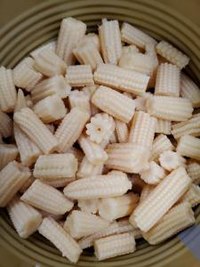
Photo from wikipedia
Abstract Corn plants were sampled over 2 consecutive years to assess the effects of corn hybrid maturity class, plant population, and harvest time on whole corn plant quality and yield… Click to show full abstract
Abstract Corn plants were sampled over 2 consecutive years to assess the effects of corn hybrid maturity class, plant population, and harvest time on whole corn plant quality and yield in Nebraska. A finishing experiment evaluated the substitution of corn with corn silage in diets with corn modified distillers grains with solubles (MDGS). The first 2 harvest dates were at the mid- and late-silage harvest times whereas the final harvest was at the grain harvest stage of plant maturity. Whole plant yields increased as harvest time progressed (yr 1 quadratic P < 0.01; yr 2 linear P < 0.01). However, differences in TDN concentration in both years were quite minimal across harvest time, because grain percentage increased but residue NDF in-situ disappearance decreased as harvest time was delayed. In the finishing experiment, as corn silage inclusion increased from 15 to 55% (DM basis) by replacing dry rolled and high moisture corn grain with corn silage in diets containing 40% MDGS, DMI, ADG, and G:F linearly decreased (P ≤ 0.01), with the steers on the 15% corn silage treatment being 1.5%, 5.0%, and 7.7% more efficient than steers on treatments containing 30, 45, and 55% corn silage, respectively. Calculated dietary NEm and NEg decreased linearly as corn silage inclusion increased indicating that net energy values were greater for corn grain than for corn silage. In addition, dressing percentage decreased linearly (P < 0.01) as silage inclusion increased suggesting more fill as silage inclusion increases in diets. Cattle fed greater than 15% corn silage in finishing diets based on corn grain will gain slower and be slightly less efficient and likely require increased days to market at similar carcass fatness and size. When 30% silage was fed with 65% MDGS, DMI, and ADG were decreased (P < 0.01) compared to feeding 30% silage with 40% MDGS suggesting some benefit to including a proportion of corn in the diet. Conversely, when 45% silage was fed with 40% MDGS, ADG, and G:F were greater (P < 0.04) than when 45% silage was fed with just grain implying a greater energy value for MDGS than for corn grain. Substituting corn silage for corn grain in finishing diets decreased ADG and G:F which would increase days to finish to an equal carcass weight; however, in this experiment, increasing corn silage levels with MDGS present reduced carcass fat thickness without significantly decreasing marbling score.
Journal Title: Translational Animal Science
Year Published: 2017
Link to full text (if available)
Share on Social Media: Sign Up to like & get
recommendations!